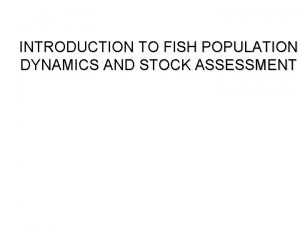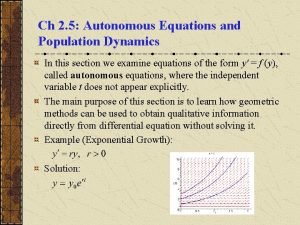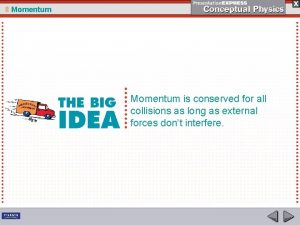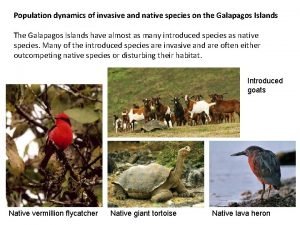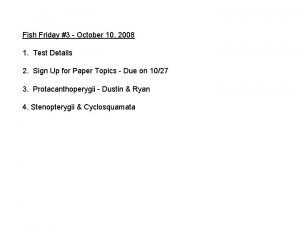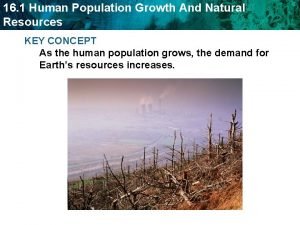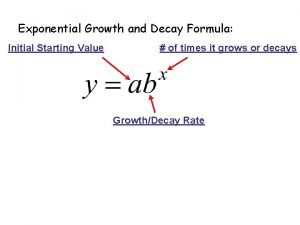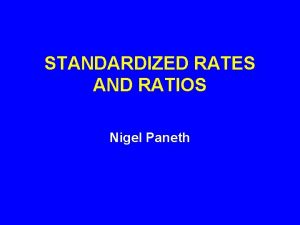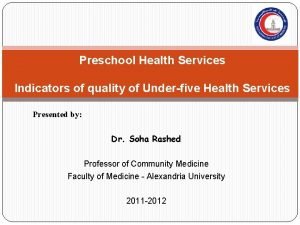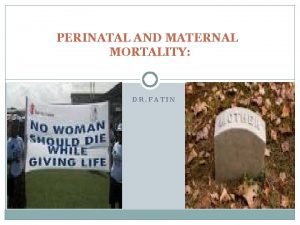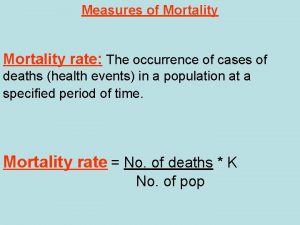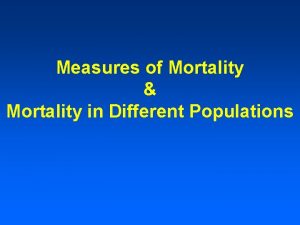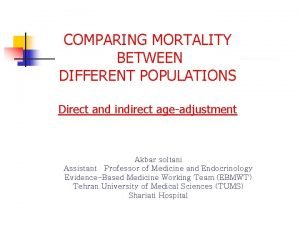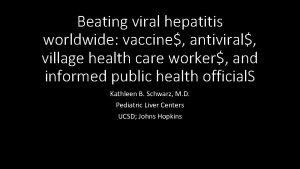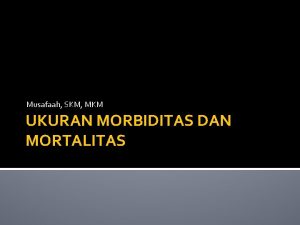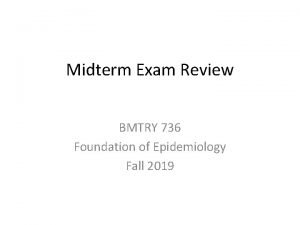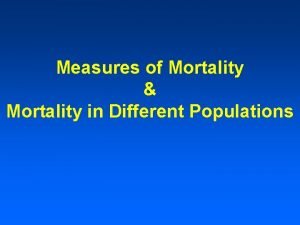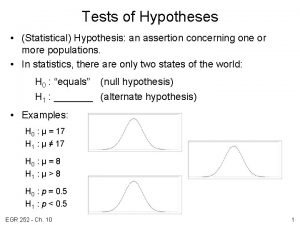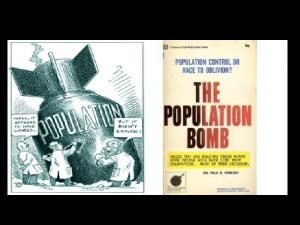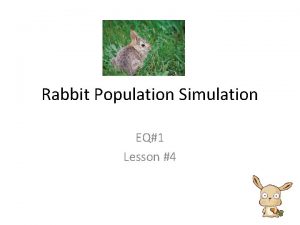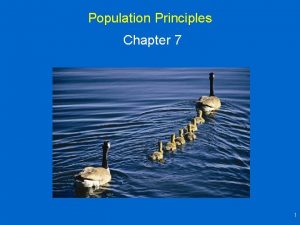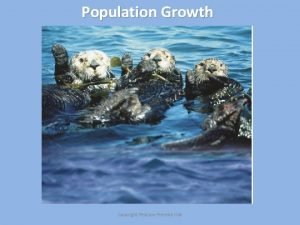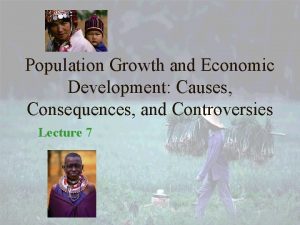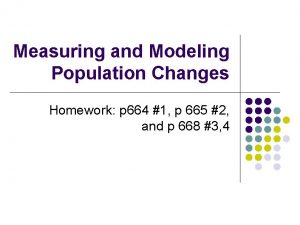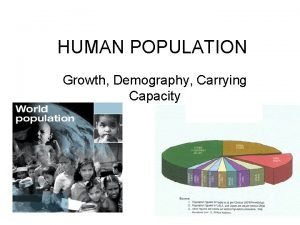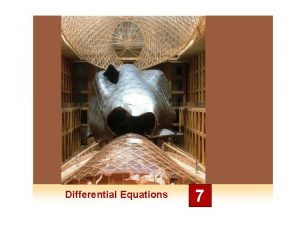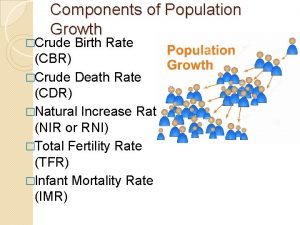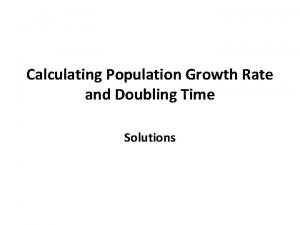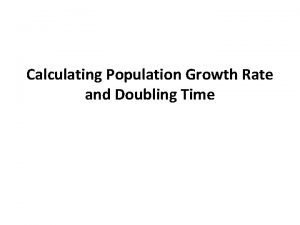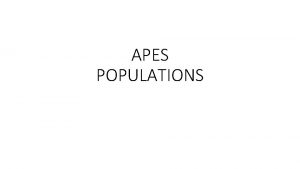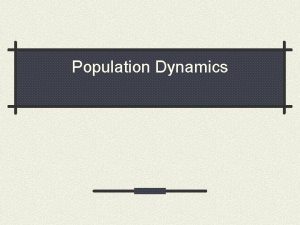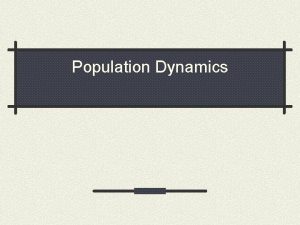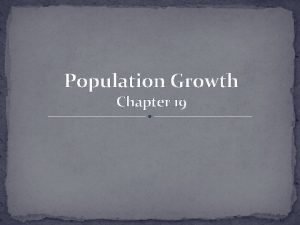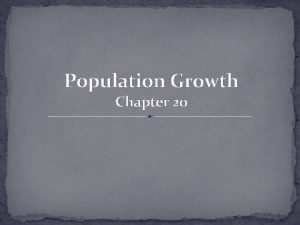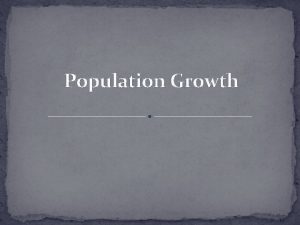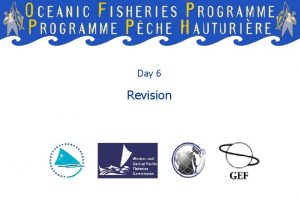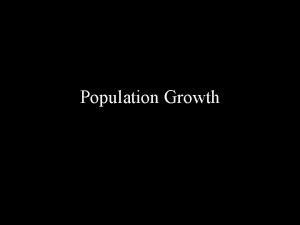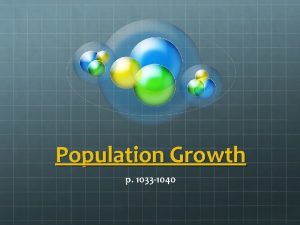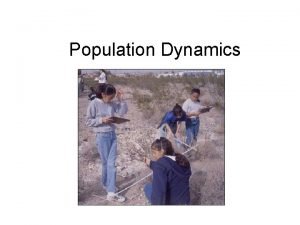Population Dynamics Mortality Growth and More Fish Growth

































































- Slides: 65

Population Dynamics Mortality, Growth, and More

Fish Growth • Growth of fish is indeterminate • Affected by: – Food abundance – Weather – Competition – Other factors too numerous to mention!

Fish Growth • Growth measured in length or weight • Length changes are easier to model • Weight changes are more important for biomass reasons

Growth rates - 3 basic types • Absolute - change per unit time - l 2 -l 1 • Relative - proportional change per unit time - (l 2 -l 1)/l 1 • Instantaneous - point estimate of change per unit time - logel 2 -logel 1

Growth in length

Growth in length & weight

von Bertalanffy growth model

Von Bertalanffy growth model

Ford-Walford Plot



More calculations For Lake Winona bluegill: K = 0. 327 L∞ = 7. 217 inches Predicting length of 5 -year-old bluegill:

Weight works, too! b often is near 3. 0

Exponential growth model Over short time periods Initial weight Weight at time t Gives best results with weight data, does not work well with lengths Instantaneous growth rate Used to compare different age classes within a population, or the same age fish among different populations

Fish Mortality Rates • Sources of mortality – Natural mortality • Predation • Diseases • Weather • Fishing mortality (harvest) Natural mortality + Fishing mortality = Total mortality

Fish Mortality Rates • Lifespan of exploited fish (recruitment phase) • Pre-recruitment phase - natural mortality only • Post-recruitment phase - fishing + natural mortality

Estimating fish mortality rates • Assumptions 1) year-to-year production constant 2) equal survival among all age groups 3) year-to-year survival constant • Stable population with stable age structure

Estimating fish mortality rates • Number of fish of a given cohort declines at a rate proportional to the number of fish alive at any particular point in time • Constant proportion (Z) of the population (N) dies per unit time (t)

Estimating fish mortality rates Number alive at time t Number alive initially - at time 0 Instantaneous total mortality rate Time since time 0

Estimating fish mortality rates If t = 1 year S = probability that a fish survives one year 1 -S=A A = annual mortality rate or


Recalling survivorship


Recalling survivorship

Mortality rates: catch data • Mortality rates can be estimated from catch data • Linear least-squares regression method • Need at least 3 age groups vulnerable to collecting gear • Need >5 fish in each age group

Mortality rates: catch data Age (t) 1 2 3 Number (Nt) 100 150 95 2 nd edition p. 144 4 5 6 53 35 17



Calculations Start with: Take natural log of both sides: Takes form of linear regression equation: Y intercept Slope = -z

slope Slope = -0. 54 = -z z = 0. 54

Annual survival, mortality S = e-z = e-0. 54 = 0. 58 = annual survival rate 58% chance of a fish surviving one year Annual mortality rate = A = 1 -S = 1 -0. 58 = 0. 42 42% chance of a fish dying during year

Robson and Chapman Method - survival estimate Total number of fish in sample (beginning with first fully vulnerable age group) Sum of coded age multiplied by frequency

Same data as previous example, except for age 1 fish (not fully vulnerable) Example Age 2 3 4 5 6 Coded age (x) 0 1 2 3 4 95 53 35 17 Number 150 (Nx) 350 total fish

Example T = 0(150) + 1(95) + 2(53) + 3(35) + 4(17) = 374 52% annual survival Annual mortality rate A = 1 -S = 0. 48 48% annual mortality

Variability estimates • Both methods have ability to estimate variability • Regression (95% CI of slope) • Robson & Chapman

Brown trout Gilmore Creek - Wildwood 1989 -2010

Separating natural and fishing mortality • Usual approach - first estimate total and fishing mortality, then estimate natural mortality as difference • Total mortality - population estimate before and after some time period • Fishing mortality - angler harvest

Separating natural and fishing mortality z=F+M z = total instantaneous mortality rate F = instantaneous rate of fishing mortality M = instantaneous rate of natural mortality

Separating natural and fishing mortality Also: A = u + v A = annual mortality rate (total) u = rate of exploitation (death via fishing) v = natural mortality rate

Separating natural and fishing mortality May also estimate instantaneous fishing mortality (F) from data on fishing effort (f) F = qf q = catchability coefficient Since Z = M + F, then Z = M + qf (form of linear equation Y = a + b. X) (q = slope M = Y intercept) Need several years of data: 1) Annual estimates of z (total mortality rate) 2) Annual estimates of fishing effort (angler hours, nets)

Separating natural and fishing mortality Once relationship is known, only need fishing effort data to determine z and F Total mortality rate (z) Mortality due to fishing M = total mortality when f = 0 Amount of fishing effort (f)

Abundance estimates • Necessary for most management practices • Often requires too much effort, expense • Instead, catch can be related to effort to derive an estimate of relative abundance

Abundance estimates • C/f = CPUE • C = catch • f = effort • CPUE = catch per unit effort • Requires standardized effort – Gear type (electrofishing, gill or trap nets, trawls) – Habitat type (e. g. , shorelines, certain depth) – Seasonal conditions (spring, summer, fall)

Abundance estimates • Often correlated with actual population estimates to allow prediction of population size from CPUE Population estimate CPUE

Population structure • Length-frequency distributions • Proportional stock density



Proportional stock density • Index of population balance derived from length-frequency distributions

Proportional stock density • Minimum stock length = 20 -26% of angling world record length • Minimum quality length = 36 -41% of angling world record length

Proportional stock density • Populations of most game species in systems supporting good, sustainable harvests have PSDs between 30 and 60 • Indicative of a balanced age structure


Relative stock density • Developed to examine subsets of quality-size fish – Preferred – 45 -55% of world record length – Memorable – 59 -64% – Trophy – 74 -80% • Provide understandable description of the fishing opportunity provided by a population

Weight-length relationships • and b is often near 3

Brown Trout Length-Weight Relationship Gilmore Creek (Wildwood) - September 2009 400 Wet weight (g) 350 300 R 2 = 0. 9884 250 200 150 100 50 0 0 5 10 15 20 Total length (cm) 25 30 35

Condition factor K = condition factor X = scaling factor to make K an integer

Condition factor • Since b is not always 3, K cannot be used to compare different species, or different length individuals within population • Alternatives for comparisons?

Relative weight Weight of individual fish Standard weight for specimen of measured length Standard weight based upon standard weight-length relations for each species

Relative weight • e. g. , largemouth bass • 450 mm bass should weigh 1414 g • If it weighed 1300 g, Wr = 91. 9 • Most favored because it allows for direct comparison of condition of different sizes and species of fish

Yield • Portion of fish population harvested by humans

Yield • Major variables – 1) mortality – 2) growth – 3) fishing pressure (type, intensity, length of season) • Limited by: – Size of body of water – Nutrients available

Yield & the Morphoedaphic Index • 70% of fish yield variation in lakes can be accounted for by this relationship • Can be used to predict effect of changes in land use

Managing for Yield • Predict effects of differing fishing effort on numbers, sizes of fish obtained from a stock on a continuing basis • Explore influences of different management options on a specific fishery

Managing for Yield • Predictions based on assumptions: • Annual change in biomass of a stock is proportional to actual stock biomass • Annual change in biomass of a stock is proportional to difference between present stock size and maximum biomass the habitat can support

Yield

Yield models Yield ½ B∞ Total Stock Biomass B∞
 Lirik lagu more more more we praise you
Lirik lagu more more more we praise you More more more i want more more more more we praise you
More more more i want more more more more we praise you One fish two fish red fish blue fish ride
One fish two fish red fish blue fish ride Fish population dynamics and stock assessment
Fish population dynamics and stock assessment Population ecology section 1 population dynamics
Population ecology section 1 population dynamics Population ecology section 1 population dynamics
Population ecology section 1 population dynamics Population ecology section 1 population dynamics
Population ecology section 1 population dynamics Population ecology section 1 population dynamics answer key
Population ecology section 1 population dynamics answer key Twofish and blowfish
Twofish and blowfish All vertebrates
All vertebrates Autonomous equations and population dynamics
Autonomous equations and population dynamics A big fish swims up and swallows a small fish at rest
A big fish swims up and swallows a small fish at rest Morbidity and mortality difference
Morbidity and mortality difference Study guide chapter 4 section 1 population dynamics
Study guide chapter 4 section 1 population dynamics Chapter 4 section 1 population dynamics
Chapter 4 section 1 population dynamics Population dynamics
Population dynamics Highfin dragonfish
Highfin dragonfish Is croaker a cartilaginous fish
Is croaker a cartilaginous fish Cartilaginous fish features
Cartilaginous fish features Sticks market form of fish
Sticks market form of fish Natural resources and population growth
Natural resources and population growth Exponential growth examples
Exponential growth examples Flacker mortality score
Flacker mortality score Dissatisfaction theme in the great gatsby
Dissatisfaction theme in the great gatsby Disease specific mortality rate formula
Disease specific mortality rate formula Underfive
Underfive Fatin organ
Fatin organ Infant mortality rate formula
Infant mortality rate formula Death rate formula
Death rate formula Age adjusted mortality rate definition
Age adjusted mortality rate definition Age adjusted mortality rate
Age adjusted mortality rate Attributable mortality
Attributable mortality Mortality formula
Mortality formula Continuous mortality investigation
Continuous mortality investigation Rumus csdr
Rumus csdr Infant mortality rate formula
Infant mortality rate formula Miracle and morality play
Miracle and morality play Infant mortality rate formula
Infant mortality rate formula Rumus cbr
Rumus cbr The cause-specific mortality rate from roller-skating was:
The cause-specific mortality rate from roller-skating was: Neonatal mortality rate formula
Neonatal mortality rate formula Health continuum pdhpe
Health continuum pdhpe Imr definition ap human geography
Imr definition ap human geography Human history becomes more and more a race
Human history becomes more and more a race Statistics hypothesis testing
Statistics hypothesis testing Rule of 70 in population growth
Rule of 70 in population growth What are the two types of population growth
What are the two types of population growth Modeling population growth rabbits answer key
Modeling population growth rabbits answer key Survivorship curve
Survivorship curve Copyright
Copyright Geometric growth vs exponential growth
Geometric growth vs exponential growth Why population growth is good
Why population growth is good Ideal population growth curve
Ideal population growth curve Logistic and exponential growth
Logistic and exponential growth Population of milton keynes 2021
Population of milton keynes 2021 Types of population growth
Types of population growth Rule of 70 in population growth
Rule of 70 in population growth Pre reproductive age
Pre reproductive age Factors affecting population explosion
Factors affecting population explosion Logistic equation
Logistic equation How to calculate annual population growth rate
How to calculate annual population growth rate Unalaska population pyramid
Unalaska population pyramid K selection r selection
K selection r selection How to calculate population growth rate
How to calculate population growth rate How to find doubling time
How to find doubling time Rule of 70 apes
Rule of 70 apes



